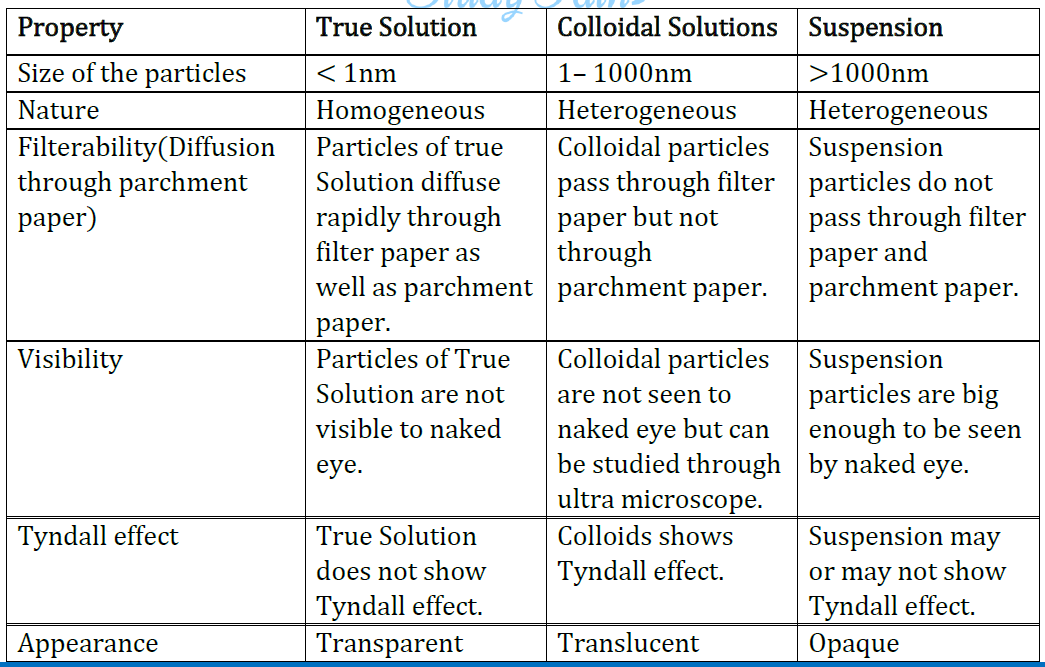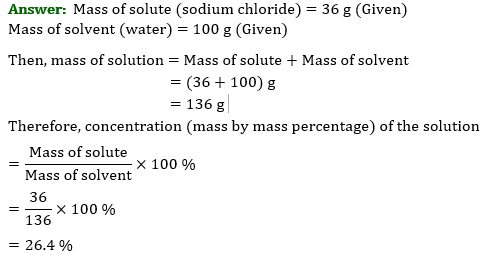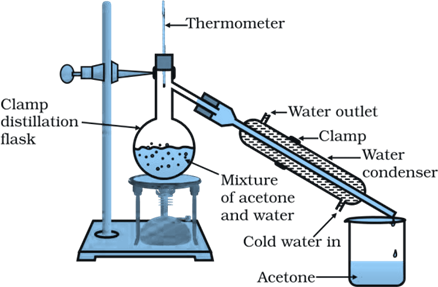NCERT Solutions for Class 9 Science Chapter 2 Is Matter Around Us Pure
NCERT Solutions for Class 9 Science (chemistry) Chapter 2 Is Matter Around Us Pure are given below. In these solutions, we have answered all the intext and exercise questions provided in NCERT class 9 science textbook. Class 9 NCERT Solutions Science Chapter 2 provided in this article are strictly based on the CBSE syllabus and curriculum. Students can easily download these solutions in PDF format for free from our app.
Class 9 Science Chapter 2 Textbook Questions and Answers
Intext Questions
Page No. 15
Questions 1: what do mean by a pure substance?
Answer: A pure substance is the one that consists of a single type of particles, i.e., all constituent particles of the substance have the same chemical nature. Pure substances can be Classified as elements or compounds.
Question 2: List the points of differences between homogeneous and heterogeneous mixtures.
Answer:
| Homogeneous mixture | Heterogeneous mixture |
| Particles are uniformly distributed throughout the mixture | All the particles are completely mixed and can be distinguished with the bare eyes or under a microscope. |
| Has a uniform composition | Irregular composition |
| No apparent boundaries of division | Noticeable boundaries of division. |
Page No. 18
Question 1: Differentiate between homogeneous and heterogeneous mixtures with examples.
Answer: A homogeneous mixture is a mixture having a uniform composition throughout the mixture. For example, mixtures of salt in water, sugar in water, copper sulphate in water, iodine in alcohol, alloy, and air have uniform compositions throughout the mixtures.
On the other hand, a heterogeneous mixture is a mixture having a non-uniform composition throughout the mixture. For example, composition of mixtures of sodium chloride and iron fillings, salt and sulphur, oil and water, chalk powder in water, wheat flour in water, milk and water are not uniform throughout the mixtures.
Or
| Heterogeneous mixture | Homogeneous mixture |
| All the particles are completely mixed and can be distinguished with the bare eyes or under a microscope. | Particles are uniformly distributed throughout the mixture |
| Irregular composition | Has a uniform composition |
| Noticeable boundaries of division. | No apparent boundaries of division |
| Example: seawater, blood, etc. | Example: rainwater, vinegar, etc. |
Question 2: How are sol, solution and suspension different from each other?
Answer: Sol is a heterogeneous mixture. In this mixture, the solute particles are so small that they cannot be seen with the naked eye. Also, they seem to be spread uniformly throughout the mixture. The Tyndall effect is observed in this mixture. For example: milk of magnesia, mud
Solution is a homogeneous mixture. In this mixture, the solute particles dissolve and spread uniformly throughout the mixture. The Tyndall effect is not observed in this mixture.
For example: salt in water, sugar in water, iodine in alcohol, alloy
Suspensions are heterogeneous mixtures. In this mixture, the solute particles are visible to the naked eye, and remain suspended throughout the bulk of the medium. The Tyndall effect is observed in this mixture.
For example: chalk powder and water, wheat flour and water
Or

Question 3: To make a saturated solution, 36 g of sodium chloride is dissolved in 100 g of water at 293 K. Find its concentration at this temperature.

PAGE NO. 24 (I)
Question 1: How will you separate a mixture containing kerosene and petrol (difference in their boiling points is more than 25°C), which are miscible with each other?
Answer: A mixture of two miscible liquids having a difference in their boiling points more than 25°C can be separated by the method of distillation. Thus, kerosene and petrol can be separated by distillation.

In this method, the mixture of kerosene and petrol is taken in a distillation flask with a thermometer fitted in it. We also need a beaker, a water condenser, and a Bunsen burner. The apparatus is arranged as shown in the above figure. Then, the mixture is heated slowly. The thermometer should be watched simultaneously. Kerosene will vaporize and condense in the water condenser. The condensed kerosene is collected from the condenser outlet, whereas petrol is left behind in the distillation flask.
Question 2: Name the technique to separate
(i) butter from curd
(ii) salt from sea-water
(iii) camphor from salt
Answer: (i) Butter can be separated from curd by centrifugation.
(ii) Salt can be separated from sea-water by evaporation.
(iii) Camphor can be separated from salt by sublimation.
Question 3: What type of mixtures is separated by the technique of crystallization?
Answer: By the technique of crystallization, pure solids are separated from impurities. For example, salt obtained from sea is separated from impurities; crystals of alum (Phitkari) are separated from impure samples.
PAGE NO 24(II)
Question 1: Classify the following as chemical or physical changes:
- Cutting of trees
- Melting of butter in a pan
- Rusting of almirah
- Boiling of water to form steam
- Passing of electric current through water and water breaking into hydrogen and oxygen gases.
- Dissolving common salt in water
- Making a fruit salad with raw fruits, and
- Burning of paper and wood
Answer: Cutting of trees → Physical change
Melting of butter in a pan → Physical change
Rusting of almirah → Chemical change
Boiling of water to form steam → Physical change
Passing of electric current through water, and water breaking down into hydrogen and oxygen gas → Chemical change
Dissolving common salt in water → Physical change
Making a fruit salad with raw fruits → Physical change
Burning of paper and wood → Chemical change
Question 2: Try segregating the things around you as pure substances or mixtures.
Answer: Listed below are the classifications based on pure substances and mixtures:
| Pure substance | Mixture |
| Water | Soil |
| Salt | Salad |
| Iron | Air |
| Diamond | Steel |
Exercises
Question 1: Which separation techniques will apply for the separation of the following?
(a) Sodium chloride from its solution in water.
(b) Ammonium chloride from a mixture containing sodium chloride and ammonium chloride.
(c) Small pieces of metal in the engine oil of a car.
(d) Different pigments from an extract of flower petals.
(e) Butter from curd.
(f) Oil from water.
(g) Tea leaves from tea.
(h) Iron pins from sand.
(i) Wheat grains from husk.
(j) Fine mud particles suspended in water.
Answer: (a) Sodium chloride from its solution in water → Evaporation
(b) Ammonium chloride from a mixture containing sodium chloride and ammonium chloride → Sublimation
(c) Small pieces of metal in the engine oil of a car → Centrifugation or filtration or decantation
(d) Different pigments from an extract of flower petals → Chromatography
(e) Butter from curd → Centrifugation
(f) Oil from water → Using separating funnel
(g) Tea leaves from tea → Filtration
(h) Iron pins from sand → Magnetic separation
(i) Wheat grains from husk → Winnowing
(j) Fine mud particles suspended in water → Centrifugation
Question 2: Write the steps you would use for making tea. Use the words –
solution, solvent, solute, dissolve, soluble, insoluble, filtrate and residue.
Answer: 1. Take a cup of water in a container as solvent and heat it.
2. Add sugar in it which is solute. Heat it till all sugar dissolves.
3. You get a solution of water and sugar.
4. Sugar is soluble in water completely.
5. Add half a tea-spoon of tea-leaves, it is insoluble in water.
6. Boil the content, add milk which is also soluble in water, boil again.
7. Filter the tea with the help of strainer, the tea collected in cup is filtrate and the tea leaves collected on the strainer is residue.

Question 3: Pragya tested the solubility of three different substances at different temperatures and collected the data as given below (results are given in the following table, as grams of substance dissolved in 100 grams of water to form a saturated solution).
(a) What mass of potassium nitrate would be needed to produce a saturated solution of potassium nitrate in 50 grams of water at 313 K?
(b) Pragya makes a saturated solution of potassium chloride in water at 353 K and leaves the solution to cool at room temperature. What would she observe as the solution cools? Explain.
(c) Find the solubility of each salt at 293 K. Which salt has the highest solubility at this temperature?
(d) What is the effect of change of temperature on the solubility of a salt?
Answer: (a) Mass of potassium nitrate required to produce a saturated solution in 100 g of water at 313 K = 62g
∴ Mass of potassium nitrate required to produce a saturated solution in 50 g of water
= (62 × 50)/100
= 31
Hence 31 g of potassium nitrate is required.
(b) Some amount of dissolved Potassium Chloride will reappear as undissolved solid as solubility of solute decreases with the decrease of temperature.
(c) Solubility of each salt at 293 K are as follows:
- Potassium nitrate – 32 g
- Sodium chloride – 36 g
- Potassium chloride – 35 g
- Ammonium chloride – 37 g
- Ammonium chloride has the highest solubility at 293 K.
(d) Solubility of salt increases with the increase in temperature.
Question 4: Explain the following giving examples.
(a) Saturated solution,
(b) Pure substance,
(c) Colloid,
(d) Suspension.
Answer: (a) Saturated Solution: A solution in which no more of the solid (solute) can be dissolved at a given temperature is called a saturated solution. Suppose 50 gm of a solute is the maximum amount that can be dissolved in 100 gm water at 298 K. Then 150 gm of solution so obtained is the saturated solution at 298 K.
Or
A saturated solution is a solution in which the maximum amount of solute has been dissolved at a given temperature. The solution cannot dissolve beyond that amount of solute at that temperature. Any more solute added will settle down at the bottom of the container as a precipitate. Suppose 500 g of a solvent can dissolve a maximum of 150 g of a particular solute at 40°C. Then, the solution obtained by dissolving 150 g of that solute in 500 g of that solvent at 300 K is said to be a saturated solution at 300 K.
Pure Substance: A pure substance consists of a single of matter or particles and cannot be separated into other kind of matter by any physical process. Pure substances always have the same colour, taste and texture at a given temperature and pressure. For example, pure water is always colourless, odorless and tasteless and boils at 373 K at normal atmospheric pressure.
Colloid: Colloid A colloid is a heterogeneous mixture. The size of the solutes in this mixture is so small that they cannot be seen individually with naked eyes, and seems to be distributed uniformly throughout the mixture. The solute particles do not settle down when the mixture is left undisturbed. This means that colloids are quite stable. Colloids cannot be separated by the process of filtration. They can be separated by centrifugation. Colloids show the Tyndall effect. For example, milk, butter, foam,fog, smoke, clouds.
Suspension: Suspension Suspensions are heterogeneous mixtures. The solute particles in this mixture remain suspended throughout the bulk of the medium. The particles can be seen with naked eyes. Suspension shows the Tyndall effect. The solute particles settle down when the mixture is left undisturbed. This means that suspensions are unstable. Suspensions can be separated by the method of filtration. For example, mixtures of chalk powder and water, wheat flour and water.
Question 5. Classify each of the following as a homogeneous or heterogeneous mixture: soda water, wood, air. soil, vinegar, filtered tea.
Answer: Homogeneous: Soda water, vinegar, filtered tea.
Heterogeneous: Wood, air, soil.
Question 6. How would, you confirm that a colourless liquid given to you is pure water?
Answer: We can confirm if a colourless liquid is pure by setting it to boil. If it boils at 100°C it is said to be pure. But if there is a decrease or increase in the boiling point, we infer that water has added impurities hence not pure.
Question 7. Which of the following materials fall in the category of a “pure substance”?
(a) Ice
(b) Milk
(c) Iron
(d) Hydrochloric acid
(e) Calcium oxide
(f) Mercury
(g) Back
(h) Wood
(i) Air.
Answer: Following substances from the above-mentioned list are pure substances:
- Iron
- Ice
- Hydrochloric acid
- Calcium oxide
- Mercury
Question 8. Identify the solutions among the following mixtures.
(a) Soil
(b) Sea water
(c) Air
(d) Coal
(e) Soda water.
Answer: The following are the solutions from the above-mentioned list of mixture:
- Sea water
- Air
- Soda water
Question 9. Which of the following will show “Tyndall effect”?
(a) Salt solution
(b) Milk
(c) Copper sulphate solution
(d) Starch solution.
Answer: Milk and starch solution will show the “Tyndall effect”.
Question 10. Classify the following into elements, compounds and mixtures.
(a) Sodium
(b) Soil
(c) Sugar solution
(d) Silver
(e) Calcium carbonate
(f) Tin
(g) Silicon
(h) Coal
(i) Air
(j) Soap
(k) Methane
(l) Carbon dioxide
(m) Blood
Answer:

Question 11. Which of the following are chemical changes?
(a) Growth of a plant
(b) Rusting of iron
(c) Mixing of iron filings and sand
(d) Cooking of food
(e) Digestion of food
(f) Freezing of water
(g) Burning of a candle.
Answer: Chemical changes are:
(a) Growth of a plant
(b) Rusting of iron
(d) Cooking of food
(e) Digestion of food
(g) Burning of candle
Class 9 Science NCERT Solutions Chapter 2 Is Matter Around Us Pure
CBSE Class 9 Science NCERT Solutions Chapter 2 helps students to clear their doubts and to score good marks in the board exam. All the questions are solved by experts with a detailed explanation that will help students complete their assignments & homework. Having a good grasp over CBSE NCERT Solutions for Class 9 Science will further help the students in their preparation for board exams and other competitive exams such as NTSE, Olympiad, etc.
NCERT Solutions for Class 9 Science Chapter 2 PDF
Below we have listed the topics discussed in NCERT Solutions for Class 9 Science Chapter 2. The list gives you a quick look at the different topics and subtopics of this chapter.
| Section in NCERT Book | Topics Discussed |
|---|---|
| 2.1 | What is a Mixture? |
| 2.2 | What is a Solution? |
| 2.2.2 | What is a Suspension? |
| 2.4 | Physical and Chemical Changes |
| 2.5 | What are the Types of Pure Substances? |